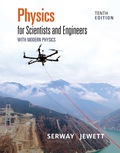
EBK PHYSICS FOR SCIENTISTS AND ENGINEER
10th Edition
ISBN: 8220106740163
Author: SERWAY
Publisher: CENGAGE L
expand_more
expand_more
format_list_bulleted
Concept explainers
Question
Chapter 13, Problem 22P
(a)
To determine
The minimum speed relative to the Sun necessary for a spacecraft to escape the solar system.
(b)
To determine
The minimum distance from the Sun in this speed to escape the solar system.
Expert Solution & Answer
Trending nowThis is a popular solution!

Students have asked these similar questions
Consider a rubber rod that has been rubbed with fur to give the rod a net negative charge, and a glass rod that has been rubbed with silk to give it a net positive charge. After being charged by contact by the fur and silk...?
a. Both rods have less mass
b. the rubber rod has more mass and the glass rod has less mass
c. both rods have more mass
d. the masses of both rods are unchanged
e. the rubber rod has less mass and the glass rod has mroe mass
8) 9)
10)
11)
12)
13)
14)
15)
Chapter 13 Solutions
EBK PHYSICS FOR SCIENTISTS AND ENGINEER
Ch. 13.1 - A planet has two moons of equal mass. Moon 1 is in...Ch. 13.2 - Superman stands on top of a very tall mountain and...Ch. 13.4 - An asteroid is in a highly eccentric elliptical...Ch. 13.6 - Prob. 13.4QQCh. 13 - In introductory physics laboratories, a typical...Ch. 13 - During a solar eclipse, the Moon, the Earth, and...Ch. 13 - Determine the order of magnitude of the...Ch. 13 - Prob. 4PCh. 13 - Review. Miranda, a satellite of Uranus, is shown...Ch. 13 - (a) Compute the vector gravitational field at a...
Ch. 13 - A spacecraft in the shape of a long cylinder has a...Ch. 13 - An artificial satellite circles the Earth in a...Ch. 13 - Prob. 9PCh. 13 - A particle of mass m moves along a straight line...Ch. 13 - Use Keplers third law to determine how many days...Ch. 13 - Prob. 12PCh. 13 - Suppose the Suns gravity were switched off. The...Ch. 13 - (a) Given that the period of the Moons orbit about...Ch. 13 - How much energy is required to move a 1 000-kg...Ch. 13 - An object is released from rest at an altitude h...Ch. 13 - A system consists of three particles, each of mass...Ch. 13 - Prob. 18PCh. 13 - A 500-kg satellite is in a circular orbit at an...Ch. 13 - Prob. 20PCh. 13 - Prob. 21PCh. 13 - Prob. 22PCh. 13 - Ganymede is the largest of Jupiters moons....Ch. 13 - Prob. 24APCh. 13 - Voyager 1 and Voyager 2 surveyed the surface of...Ch. 13 - Prob. 26APCh. 13 - Prob. 27APCh. 13 - Why is the following situation impossible? A...Ch. 13 - Let gM represent the difference in the...Ch. 13 - Prob. 30APCh. 13 - Prob. 31APCh. 13 - Prob. 32APCh. 13 - Prob. 33APCh. 13 - Two spheres having masses M and 2M and radii R and...Ch. 13 - (a) Show that the rate of change of the free-fall...Ch. 13 - Prob. 36APCh. 13 - Studies of the relationship of the Sun to our...Ch. 13 - Review. Two identical hard spheres, each of mass m...Ch. 13 - Prob. 39APCh. 13 - Prob. 40APCh. 13 - Prob. 41APCh. 13 - Prob. 42APCh. 13 - As thermonuclear fusion proceeds in its core, the...Ch. 13 - Two stars of masses M and m, separated by a...Ch. 13 - The Solar and Heliospheric Observatory (SOHO)...
Knowledge Booster
Learn more about
Need a deep-dive on the concept behind this application? Look no further. Learn more about this topic, physics and related others by exploring similar questions and additional content below.Similar questions
- Mick and Rick are twins born on Earth in the year 2175. Rick grows up to be an Earth-bound robotics technician while Mick becomes an intergalactic astronaut. Mick leaves the Earth on his first space mission in the year 2200 and travels, according to his clock, for 10 years at a speed of 0.75c. Unfortunately, at this point in his journey, the structure of his ship undergoes mechanical breakdown and the ship explodes. How old is Rick when his brother dies?arrow_forwardHi, I have canceled, why did you charge me again?arrow_forwardNo chatgpt pls will upvotearrow_forward
arrow_back_ios
SEE MORE QUESTIONS
arrow_forward_ios
Recommended textbooks for you
 Classical Dynamics of Particles and SystemsPhysicsISBN:9780534408961Author:Stephen T. Thornton, Jerry B. MarionPublisher:Cengage Learning
Classical Dynamics of Particles and SystemsPhysicsISBN:9780534408961Author:Stephen T. Thornton, Jerry B. MarionPublisher:Cengage Learning Principles of Physics: A Calculus-Based TextPhysicsISBN:9781133104261Author:Raymond A. Serway, John W. JewettPublisher:Cengage Learning
Principles of Physics: A Calculus-Based TextPhysicsISBN:9781133104261Author:Raymond A. Serway, John W. JewettPublisher:Cengage Learning Physics for Scientists and Engineers: Foundations...PhysicsISBN:9781133939146Author:Katz, Debora M.Publisher:Cengage Learning
Physics for Scientists and Engineers: Foundations...PhysicsISBN:9781133939146Author:Katz, Debora M.Publisher:Cengage Learning University Physics Volume 1PhysicsISBN:9781938168277Author:William Moebs, Samuel J. Ling, Jeff SannyPublisher:OpenStax - Rice University
University Physics Volume 1PhysicsISBN:9781938168277Author:William Moebs, Samuel J. Ling, Jeff SannyPublisher:OpenStax - Rice University Glencoe Physics: Principles and Problems, Student...PhysicsISBN:9780078807213Author:Paul W. ZitzewitzPublisher:Glencoe/McGraw-Hill
Glencoe Physics: Principles and Problems, Student...PhysicsISBN:9780078807213Author:Paul W. ZitzewitzPublisher:Glencoe/McGraw-Hill Physics for Scientists and Engineers, Technology ...PhysicsISBN:9781305116399Author:Raymond A. Serway, John W. JewettPublisher:Cengage Learning
Physics for Scientists and Engineers, Technology ...PhysicsISBN:9781305116399Author:Raymond A. Serway, John W. JewettPublisher:Cengage Learning

Classical Dynamics of Particles and Systems
Physics
ISBN:9780534408961
Author:Stephen T. Thornton, Jerry B. Marion
Publisher:Cengage Learning

Principles of Physics: A Calculus-Based Text
Physics
ISBN:9781133104261
Author:Raymond A. Serway, John W. Jewett
Publisher:Cengage Learning

Physics for Scientists and Engineers: Foundations...
Physics
ISBN:9781133939146
Author:Katz, Debora M.
Publisher:Cengage Learning

University Physics Volume 1
Physics
ISBN:9781938168277
Author:William Moebs, Samuel J. Ling, Jeff Sanny
Publisher:OpenStax - Rice University

Glencoe Physics: Principles and Problems, Student...
Physics
ISBN:9780078807213
Author:Paul W. Zitzewitz
Publisher:Glencoe/McGraw-Hill

Physics for Scientists and Engineers, Technology ...
Physics
ISBN:9781305116399
Author:Raymond A. Serway, John W. Jewett
Publisher:Cengage Learning